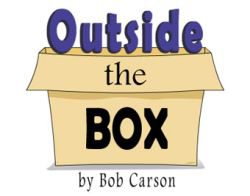Double Down
June 17, 2019,Editor’s Note: The USTA website is pleased to present freelance writer Bob Carson and his popular “Outside the Box” features. This monthly series is a menu of outlandish proposals presented with a wink — but the purpose behind them is serious. The views contained in this column are that of the author alone, and do not necessarily represent the opinions or views of the United States Trotting Association.
Imagine you are sitting at your desk using your I-pad or your phone to wager on harness races. You select a racetrack that streams their races in high definition, perhaps Hoosier Park. After carefully studying the program and using your favorite handicapping methods, you decide to wager a $1 trifecta box using four numbers — 1, 3, 6 and 7.
At one minute before the posted off time, you notice the odds on the tote board appear favorable. You lock in your wager on your device. You receive a confirmation message on your screen that $24 has transferred from your account. Your 1-3-6-7 trifecta is official. This gives you 24 possible winning combinations. As always, you are hopeful your wager will be a winner.
As the horses warm up for the race, you anxiously watch your screen for the race to begin. You listen to some commentary or at least some music. Eventually, the horses in this race assemble behind the starting car and you lean forward watching your screen more intently than usual, much more intently than usual. In fact, you make sure that your index finger is near your device.
 The reason for your increased attention is that this race is slightly different than the hundreds, perhaps thousands, of races that you have previously wagered. There will be a window in this race. You will have the opportunity to make a split second decision during the race.
The reason for your increased attention is that this race is slightly different than the hundreds, perhaps thousands, of races that you have previously wagered. There will be a window in this race. You will have the opportunity to make a split second decision during the race.
They are off!
The drivers make decisions on how to situate their horse. The announcer begins his call as the hooves pound the dirt. The story of this race begins to unfold. The difference in this race is that the instant the lead horse reaches the half-mile point a green button will light up on your I-pad. This light will remain green for four seconds. These four seconds of activation will be a window where you will have the opportunity to double your wager. You will need to be alert; four seconds pass quickly.
If you activate successfully, the green light will turn yellow, indicating you doubled your original wager. If you do not activate, the green button icon will disappear from your wagering display.
This option may seem insignificant, but it is not. The ability to participate in real time, to make a decision during the race, is huge. It allows gamblers to be active, not just passive. Gamblers who decide to use, or not to use, the double down option in this race are making a real-time decision.
That first half of a race with a decision point looming is a very busy time for your brain. You have four horses to track, mathematical calculations to make, racing patterns to consider. Your eyes dart to see, your brain races to process — are my closers close enough, did horses 6 and 7 get into the flow or are they hopelessly shuffled back, was the number 3 horse pushed too hard in the first quarter-mile? Watching the race to see how it is developing, and how your particular horses are doing at the halfway point, ramps up the stakes and your intensity.
What a great mixture of horse racing chaos under high pressure with the clock ticking to the double down window. An important decision awaits. This would be comparable to transforming you from passively watching the game show Jeopardy on your television, to suddenly holding that buzzer button in your hand with real money at stake.
The window in this conceptual double down race opens harness racing to an increased amount of activity and to different types of players. Concepts like this, and no doubt you can imagine similar real-time wagering options, are ways to use technology to invigorate and enhance our product. Ideas such as Double Down may require tinkering and experimentation but they can bring new revenue and new faces to our sport.
Real-time options for harness racing gambling may appear outrageous. Some will immediately look for problems such as recalculation of odds, technology implementation problems, monitoring, and who would take the initiative for such a radical adaptation. Others will fly right past potential obstacles and instead look at the possibilities.
Change is difficult for our sport. Change is difficult in any business. Every single day, organizations and businesses choose failure over change. The concept that change is inevitable and resistance is futile is very difficult to grasp, and even more difficult to act upon. Usually, change is a path to growth and stability.
A trial wager of this style could be and should be, optional. We never want to alienate customers. If real-time wagering feels too exotic, our customers can just continue playing the horse races as usual. However, for old customers looking for an infusion of excitement and for potential players, windows like this should be open.
It is always a good idea to double down on the future.

